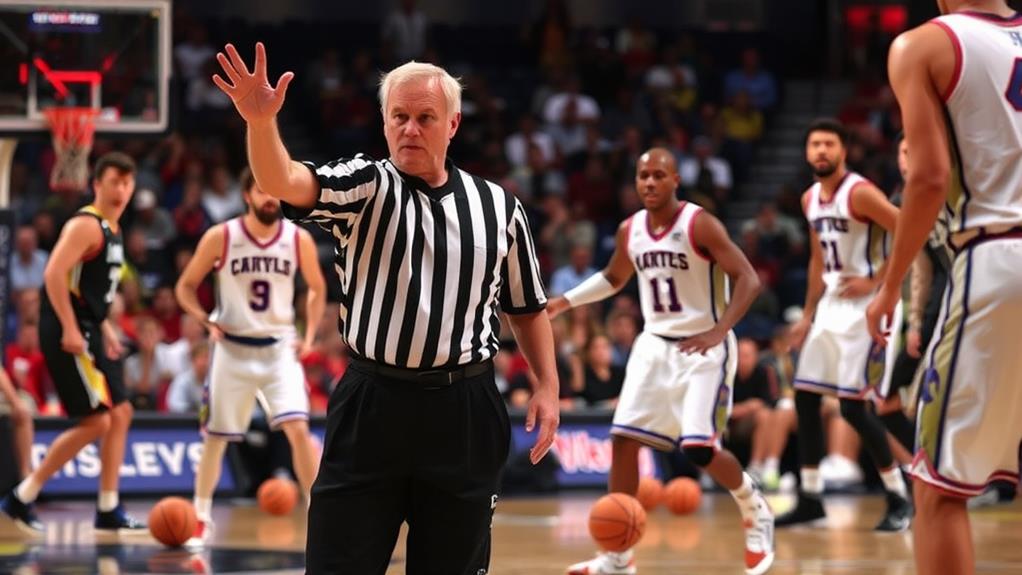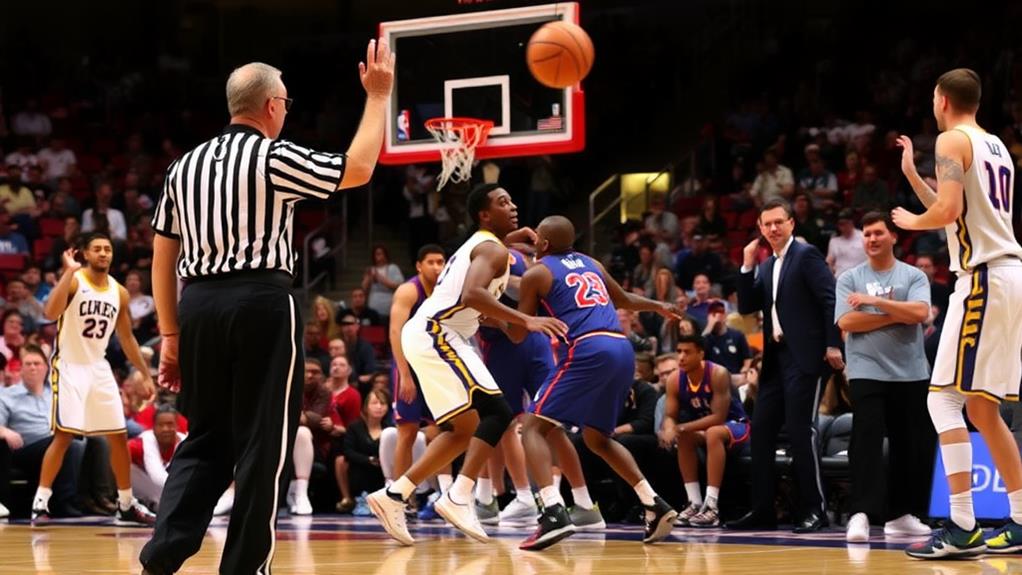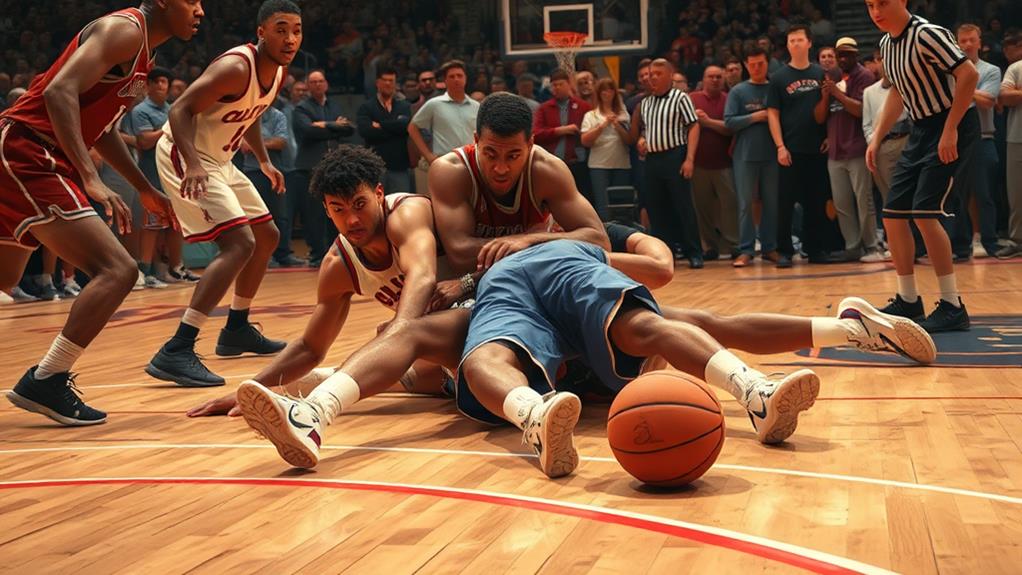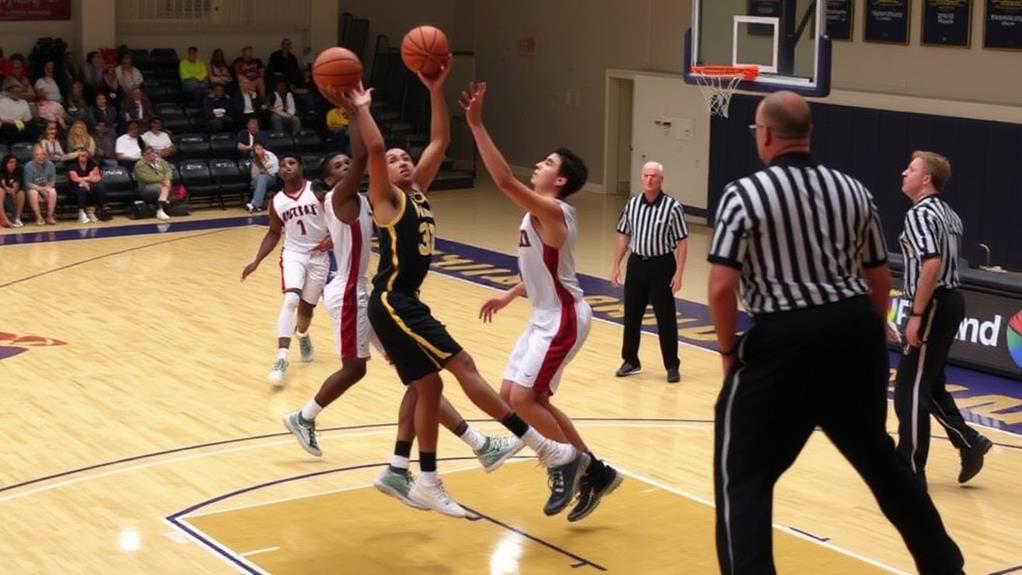
Loose Ball Foul: Definition, Rules, and Game Impact
September 16, 2024A loose ball foul happens when you or your opponent initiate illegal contact while neither team has possession of the ball. This often occurs during chaotic moments like rebounds or fumbled passes. Both offensive and defensive players can be penalized, counting as personal fouls toward team totals. These fouls disrupt the game, potentially leading to free throws for the opposing team if a team exceeds foul limits. It's essential to be aware of positioning and avoid unnecessary contact to prevent these fouls. There's much more to explore about the rules and strategies surrounding loose ball fouls.
What Is a Loose Ball Foul?
When you're watching a basketball game, you might notice instances where players collide while scrambling for the ball—this is what we call a loose ball foul. A loose ball foul occurs when physical contact is made between players while neither team has possession of the basketball. It's a common sight during moments like rebounds, deflections, or fumbled passes, similar to how players must adhere to specific rules during gameplay, such as the offside rule.
Both offensive and defensive players can be called for this type of foul.
When a loose ball foul is committed, it results in a personal foul for the player involved. This personal foul counts toward their total team fouls, and accumulating five fouls can lead to their disqualification from the game. If the fouled team is in a bonus situation, they're awarded two free throws. If not, the opposing team gains possession of the basketball out of bounds near where the foul occurred.
Loose ball fouls can disrupt the flow of the game, often leading to chaotic situations that might result in injuries. Understanding loose ball fouls helps you appreciate the intensity and strategy behind the game, as players navigate the challenges of physical contact while vying for control of the ball.
Examples of Loose Ball Fouls
Loose ball fouls can manifest in various scenarios during a basketball game. One common situation arises during a jump ball, where players make illegal contact while vying for possession.
If you're in the paint trying to secure a rebound and inadvertently push an opponent, that's a loose ball foul. It can also happen when both players are pursuing a ball that's been mishandled, resulting in illegal contact as you scramble for control.
Understanding the importance of proper form and technique can help minimize such fouls during intense plays. In a fast-paced game, these fouls often occur when players dive for the ball, and the physical nature of the play increases.
For instance, if a player commits a foul while chasing after a loose ball after a turnover, it's classified as a loose ball foul. Maintaining legal positioning is essential; focusing on minimizing contact can help you avoid these calls.
Understanding these examples of loose ball fouls can enhance your gameplay. By recognizing when these fouls are likely to occur, you can adjust your strategy to maintain possession without drawing penalties, keeping the game flowing smoothly.
Penalties for Loose Ball Fouls

When you commit a loose ball foul, it counts as a personal foul, and accumulating five can send you to the bench for the rest of the game.
This is essential, as teams must maintain discipline to avoid detrimental impacts on their overall performance, much like how a team facing relegation must consistently secure points to stay competitive in their league relegation impacts club finances considerably.
Depending on whether your team is in a bonus situation, the consequences can vary greatly, from free throws to simply losing possession of the ball.
Plus, these fouls add to your team's total, which could lead to even more penalties for your opponents if you exceed the foul limit.
Personal Foul Classification
In basketball, personal fouls encompass various infractions, including loose ball fouls, which can greatly affect gameplay. A loose ball foul is classified as a personal foul, counting towards your total foul limit. In most leagues, accumulating five fouls can lead to disqualification, putting pressure on you to manage your fouls effectively.
When a loose ball foul occurs, the outcome depends on the fouled team's bonus situation. If they're in the bonus, they're awarded two free throw attempts, providing an essential scoring opportunity. Conversely, if they're not in the bonus, they gain possession of the ball out of bounds near the foul's location, allowing for a strategic advantage.
These penalties increase your team's foul count, which can force coaches to rethink strategies and manage players differently. The disruption caused by loose ball fouls can shift game dynamics, impacting momentum and overall effectiveness on the court.
As a player, being aware of these classifications and their consequences helps you navigate the game more intelligently, ultimately contributing to your team's success.
Bonus and Non-Bonus Situations
Understanding bonus and non-bonus situations is essential for players, as they directly influence the consequences of loose ball fouls.
When your team exceeds the team foul limit within a quarter, a loose ball foul results in a bonus situation, granting your opponents two free throw attempts. This can quickly shift the game's momentum in their favor, adding pressure on your defense.
Conversely, if your team isn't in the bonus, the fouled team is awarded possession of the ball out of bounds near the location of the foul instead of free throw attempts.
This scenario can also impact game strategy, as you'll need to refocus your defense to prevent an easy score from the inbound play.
Team Foul Implications
During a game, the implications of team fouls can greatly affect your strategy and performance. A loose ball foul counts as a personal foul, contributing to your players' total foul count. If a player accumulates five fouls, they risk disqualification, putting your team at a disadvantage.
When your opponent commits a loose ball foul and is in a bonus situation, they receive two free throw attempts, which can turn the tide of the game in their favor.
On the other hand, if your team commits a loose ball foul in a non-bonus situation, the opposing team gains possession of the ball near the foul location. This can disrupt your game momentum and create scoring opportunities for them.
Additionally, every loose ball foul adds to your team foul count, potentially leading to bonus situations for the opponent later in the game.
It's essential to be aware of these implications. A high foul count not only increases the chances of free throw attempts for your opponent but can also change how aggressively you play.
Avoiding technical fouls and managing team fouls strategically helps maintain your competitive edge.
Tips to Avoid Loose Ball Fouls
Loose ball situations can be chaotic, but avoiding fouls is essential for staying in the game. To keep yourself in the action, focus on maintaining your hands on the ball. When you're battling for rebounds, be aware of your positioning to prevent any illegal contact that could result in a foul.
Remember, unnecessary physical contact with opponents can lead to trouble. Practicing passing accuracy techniques can also enhance your ability to maneuver around opponents without committing fouls.
Practicing safe diving techniques is vital when going after loose balls. Aim to retrieve the ball cleanly and avoid targeting your opponent's legs. This approach not only helps you stay legal but also keeps everyone on the court safe.
Staying conscious of your surroundings is equally important; keep an eye on the movements of other players to minimize the chance of illegal contact.
Emphasizing proper body positioning and footwork will enhance your ability to engage in legal plays. By doing this, you'll reduce the likelihood of committing a loose ball foul.
Dangers of Loose Ball Fouls

The dangers of loose ball fouls can have serious consequences for both players and teams. When players scramble for the ball, the high-speed environment often leads to aggressive contact, increasing the risk of player injuries. This chaotic situation can heighten tensions on the court, making it easier for officials to call technical fouls against players who lose their composure.
Additionally, consistent effort is essential for refining skills in high-pressure situations, which can help players navigate the risks associated with loose ball scenarios.
Moreover, excessive or unnecessary contact during a loose ball foul might escalate to a flagrant foul, resulting in severe penalties, including ejections. Such actions not only jeopardize a player's participation in the game but also disrupt the flow of play, negatively affecting team momentum.
When the rhythm of the game is interrupted, teams miss scoring opportunities and struggle to regain their footing.
Accumulating too many loose ball fouls poses strategic disadvantages as well. Key players may face disqualification after reaching foul limits, leaving teams vulnerable.
Ultimately, loose ball fouls can greatly impact a game, altering outcomes and determining which team has the upper hand. It's vital to understand these dangers to mitigate their effects and maintain a competitive edge on the court.
Situations Leading to Loose Ball Fouls
Loose ball fouls often happen in common scenarios like jump balls or when players scramble for a fumbled pass.
These situations not only highlight the urgency and competitive spirit of the game but also reflect the importance of inclusivity and equality in sports.
You might notice that illegal contact tends to increase during these chaotic moments, affecting the game's flow.
Understanding these situations can help you appreciate the impact player contact has on the outcome of a game.
Common Loose Ball Scenarios
When you're watching a basketball game, you might notice that loose ball fouls often happen in high-pressure situations where players are battling for possession.
One common scenario occurs during jump balls, where players make illegal contact while vying for control, as there's no team control at that moment. Rebounding situations frequently lead to loose ball fouls, especially when players push or hold each other while trying to secure the rebound after a missed shot.
Another situation arises when a loose ball results from a fumbled pass or a dribbling loss. In the scramble for the ball, players might engage in illegal contact.
Defensive players can also commit loose ball fouls by interfering with an offensive player who's attempting to recover a rolling or bouncing ball on the court.
After a field goal attempt, the action doesn't stop; players often collide as they compete for the loose ball, which can also lead to fouls being called.
Each of these scenarios showcases how the intensity of the game can lead to loose ball fouls, impacting the flow and strategy of play.
Impact of Player Contact
In high-pressure moments of a basketball game, player contact can greatly influence the occurrence of loose ball fouls. When players scramble for possession of a loose ball, the physicality often ramps up, creating a perfect storm for fouls. For instance, during rebound attempts, you might see players pushing or holding each other to gain that vital edge. This illegal contact can lead to a referee calling a loose ball foul.
Situations like fumbled passes or lost dribbles also contribute to these fouls. As the ball slips away, players tend to make aggressive moves, resulting in illegal contact that disrupts the flow of the game.
Even during jump balls, when neither team holds possession, physical confrontations can arise, leading to fouls if players engage in illegal maneuvers.
The fast-paced nature of basketball exacerbates these situations. In the heat of the moment, players may inadvertently commit fouls while desperately vying for control of the ball.
Understanding these scenarios helps you appreciate how essential managing player contact is in minimizing loose ball fouls and maintaining a fair competitive environment.
Team Control and Foul Assessment

Understanding team control is essential for evaluating fouls in basketball, as it directly influences how the game is played during contested situations. Team control exists when a player holds, dribbles, or passes the ball, and it ceases once a field goal attempt is made or the ball is deflected by a defensive player.
In soccer, similar concepts apply regarding possession and fouls; for instance, players must be aware of their positioning to avoid offside infractions, which can also impact team control during a match the offside rule. In the absence of team control, you'll encounter loose ball scenarios, where illegal contact can occur between players competing for possession.
During these game situations, personal fouls may be assessed against those involved, affecting their overall foul count. Recognizing when team control is established or lost is vital for players and coaches alike.
For instance, when the ball is in flight or during jump balls, there's no team control, making it easier for officials to assess fouls appropriately. By understanding this distinction, you can develop strategies to minimize penalties and enhance your team's ability to maintain possession during play.
Ultimately, grasping the concept of team control not only aids in foul assessment but also helps you navigate the complexities of the game more effectively.
Implications of Loose Ball Fouls
Loose ball fouls can dramatically shape the outcome of a basketball game. When these fouls occur, they disrupt the game flow, often leading to a change in possession. The team that didn't commit the foul is awarded the ball, which can shift momentum. If the fouled team is in a bonus situation, they gain two free throw attempts, providing critical scoring opportunities that can alter the scoreline dramatically. This is particularly significant in the context of global basketball expansion, where the stakes and competitiveness are continually evolving.
Accumulating personal fouls from loose ball situations can have serious implications for players. Most leagues allow a maximum of five fouls before a player faces disqualification, forcing coaches to adjust their team strategies accordingly. This management of foul counts is essential for maintaining player availability and effectiveness throughout the game.
Furthermore, loose ball fouls tend to happen during high-intensity moments, increasing the physicality on the court and the risk of injuries. As players scramble for possession, the chaotic nature of the play can lead to important injuries that may sideline key players.
Essentially, understanding the implications of loose ball fouls is significant for both players and coaches as they navigate the complexities of a competitive basketball environment.
Types of Related Fouls

Basketball games are often punctuated by various types of fouls, each carrying its own set of rules and consequences. Understanding these fouls, especially loose ball fouls, helps you navigate the game more effectively.
Here are some key types of related fouls:
- Loose Ball Fouls: These are personal fouls that occur when players make illegal contact while fighting for a ball that isn't in possession of either team.
- Personal Fouls: This broader category includes blocking, charging, and holding fouls, all involving illegal physical contact between players.
- Technical Fouls: Unlike personal fouls, these result from violations of game conduct, such as unsportsmanlike behavior or failing to comply with specific rules.
- Flagrant Fouls: These involve unnecessary or excessive contact. During loose ball situations, a flagrant foul can lead to severe penalties if the contact is deemed reckless.
Conclusion
In basketball, avoiding loose ball fouls is like maneuvering a crowded dance floor—you've got to be aware of your surroundings and respect others' space. Just like stepping on someone's toes can ruin the rhythm of a dance, a careless foul can disrupt your team's flow and lead to costly penalties. By keeping your head up and maintaining control, you'll not only enhance your game but also help your team glide smoothly toward victory.


